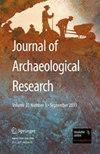Evaluating Social Complexity and Inequality in the Balkans Between 6500 and 4200 BC
IF 4.1
1区 历史学
Q1 ANTHROPOLOGY
引用次数: 0
Abstract
The subject of this paper is the social structure and sociocultural evolution of Balkan Neolithic and Eneolithic societies between 6500 and 4200 BC. I draw on archaeological evidence from three major regions of the Balkans related to demography, settlement, economy, warfare, and differences in status and wealth between individuals and groups to evaluate the degree and kind of social complexity and inequality. The trend in these data is of increase in social complexity and inequality over two millennia following the introduction of agriculture to the Balkans, as the simple and small hamlets of the late seventh and early sixth millennia transformed into large villages and tell sites of the late sixth and fifth millennia, in parallel with the development of copper metallurgy and regional exchange networks. There is no evidence of social stratification or the formation of complex systems of regional integration such as (proto)states or urban centers. The Balkan communities of this period were essentially village communities with social inequalities, when present, limited to differences in prestige and potentially rank.评估公元前 6500 至 4200 年巴尔干地区的社会复杂性和不平等性
本文的主题是公元前 6500 年至公元前 4200 年巴尔干新石器时代和新石器时代社会的社会结构和社会文化演变。我利用巴尔干半岛三个主要地区的考古证据,从人口、定居、经济、战争以及个人和群体之间的地位和财富差异等方面来评估社会复杂性和不平等的程度和类型。这些数据表明,在巴尔干半岛引入农业后的两千年里,社会复杂性和不平等程度呈上升趋势,七世纪末和六世纪初的简单小村庄转变为六世纪末和五世纪的大型村庄和遗址,与此同时,铜冶金业和地区交流网络也得到了发展。没有证据显示社会分层或形成复杂的地区一体化体系,如(原)国家或城市中心。这一时期的巴尔干社区基本上是村落社区,即使存在社会不平等,也仅限于声望和潜在等级的差异。
本文章由计算机程序翻译,如有差异,请以英文原文为准。
求助全文
约1分钟内获得全文
求助全文
来源期刊

Journal of Archaeological Research
Multiple-
CiteScore
10.20
自引率
7.90%
发文量
9
期刊介绍:
Journal of Archaeological Research publishes the most recent international research summaries on a broad range of topics and geographical areas. The articles are intended to present the current state-of-the-discipline in regard to a particular geographic area or specific research topic or theme. This authoritative review journal improves access to the growing body of information and literature through the publication of original critical articles, each in a 25-40 page format.2-Year Impact Factor: 4.056 (2017) 5-Year Impact Factor: 4.512 (2017)2 out of 85 on the Anthropology listIncluded in the European Reference Index for the Humanities (ERIH) PLUS The European Reference Index for the Humanities and the Social Sciences (ERIH PLUS) was created and developed by European researchers under the coordination of the Standing Committee for the Humanities (SCH) of the European Science Foundation (ESF). https://dbh.nsd.uib.no/publiseringskanaler/erihplus/about/indexSCImago Journal and Country Rank (SJR) 2018: 1.7102 out of 263 on the Archeology (Arts and Humanities) list3 out of 254 on the Archeology list2 out of 131 on the General Arts and Humanities listSJR is a measure of the journal’s relative impact in its field, based on its number of citations and number of articles per publication year.Source Normalised Impact per Paper (SNIP) 2018: 2.112The SNIP measures contextual citation impact by weighting citations based on the total number of citations in a subject field. The impact of a single citation is given higher value in subject areas where citations are less likely, and vice versa.CiteScore 2018: 3.86Rated ''A'' in the Australian Research Council Humanities and Creative Arts Journal List. For more information, visit: http://www.arc.gov.au/era/journal_list.htm
SCImago Journal and Country Rank (SJR) 2011 1.227 Archeology 1 out of 96 Archeology (Arts and Humanities) 1 out of 59 Arts and Humanities (miscellaneous) 1 out of 243
 求助内容:
求助内容: 应助结果提醒方式:
应助结果提醒方式:


